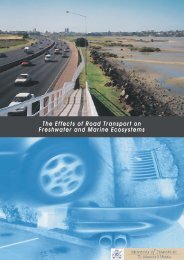Auckland City Centre Rail Link - Business Case Review - Ministry of ...
Auckland City Centre Rail Link - Business Case Review - Ministry of ...
Auckland City Centre Rail Link - Business Case Review - Ministry of ...
Create successful ePaper yourself
Turn your PDF publications into a flip-book with our unique Google optimized e-Paper software.
<strong>Auckland</strong> <strong>City</strong> <strong>Centre</strong> <strong>Rail</strong> <strong>Link</strong> <strong>Business</strong> <strong>Case</strong> <strong>Review</strong> | May 2011<br />
an increase in the residential population <strong>of</strong> 84,000, from 17,900 in 2006 to<br />
102,000 in 2041<br />
an increase in full time equivalent jobs <strong>of</strong> 58,305, from 63,800 in 2006 to 122,105<br />
in 2041<br />
The ARLTS land use inputs are based on the former <strong>Auckland</strong> Regional Council‘s<br />
Regional Growth Strategy, as embodied in Plan Change Six. Land use categories<br />
were manually adjusted on a zone by zone basis to match the Plan Change 6<br />
desired outcomes for each zone.<br />
Achieving the ARLTS forecasts for CBD employment will require an increased rate <strong>of</strong><br />
employment growth in the CBD in comparison to past trends. It will also require the<br />
CBD to increase its share <strong>of</strong> overall employment. The available data outlined below<br />
in Table 14, shows recent average annual growth rates, for a 9 to 10 year period, <strong>of</strong><br />
between 1.4 and 1.7 percent, with a peak <strong>of</strong> around 2.0 percent during the period <strong>of</strong><br />
strong economic growth between 2000 and 2006.<br />
Table 14: CBD employment trends 1996-2009 19<br />
Source 1996 2000/<br />
2001<br />
2006 2009 Average<br />
annual<br />
growth<br />
percentage<br />
Statistics NZ Census (total<br />
workforce)<br />
Price Waterhouse Coopers<br />
Waterfront Study (Full Time<br />
Equivalents)<br />
<strong>Business</strong> <strong>Case</strong>, Appendix K<br />
(total employment)<br />
<strong>Auckland</strong> <strong>City</strong> Council<br />
(employment)<br />
50,907 50,823 60,075 1.7<br />
82,677 93,566 1.4<br />
71,170 81,200 1.5<br />
80,059 90,600 2.1<br />
The ARLTS forecasts for the CBD require an average annual growth rate <strong>of</strong> 1.9<br />
percent per annum (pa). This compares to a forecast growth rate <strong>of</strong> 1.5 percent pa<br />
for regional employment to 2041, and therefore requires the CBD to increase its<br />
share <strong>of</strong> employment from 12.3 percent (using ARLTS figures) to 14.1 percent. The<br />
ARLTS figures for the CBD can also be compared to a forecast by the former<br />
<strong>Auckland</strong> <strong>City</strong> Council. Their medium forecast predicted employment growth <strong>of</strong><br />
53,200 (from 90,600 in 2006 to 143,800 in 2041) which requires an average annual<br />
growth rate <strong>of</strong> 1.3 percent.<br />
The ARLTS figures for CBD employment growth seem slightly ambitious in light <strong>of</strong><br />
recent trends. However, they were used in the <strong>Review</strong> for modelling transport and<br />
WEBs to ensure consistency with other project appraisal and regional planning. The<br />
<strong>Review</strong>‘s key conclusion is that assumptions for additional CBD employment growth<br />
beyond the ARLTS forecasts require rates <strong>of</strong> growth that become increasingly<br />
19 There are significant differences in employment estimates for the CBD depending on the source. The <strong>Review</strong> has<br />
not attempted to resolve these differences, but they are likely to be explained, in part, by different employment<br />
definitions and survey areas.<br />
36
















